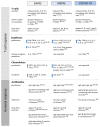Immune Response to COVID-19: Can We Benefit from the SARS-CoV and MERS-CoV Pandemic Experience?
- PMID: 32916812
- PMCID: PMC7559562
- DOI: 10.3390/pathogens9090739
Immune Response to COVID-19: Can We Benefit from the SARS-CoV and MERS-CoV Pandemic Experience?
Abstract
The global range and high fatality rate of the newest human coronavirus (HCoV) pandemic has made SARS-CoV-2 the focus of the scientific world. Next-generation sequencing of the viral genome and a phylogenetic analysis have shown the high homology of SARS-CoV-2 to other HCoVs that have led to local epidemics in the past. The experience acquired in SARS and MERS epidemics may prove useful in understanding the SARS-CoV-2 pathomechanism and lead to effective treatment and potential vaccine development. This study summarizes the immune response to SARS-CoV, MERS-CoV, and SARS-CoV-2 and focuses on T cell response, humoral immunity, and complement system activation in different stages of HCoVs infections. The study also presents the quantity and frequency of T cell responses, particularly CD4+ and CD8+; the profile of cytokine production and secretion; and its relation to T cell type, disease severity, and utility in prognostics of the course of SARS, MERS, and COVID-19 outbreaks. The role of interferons in the therapy of these infections is also discussed. Moreover, the kinetics of specific antibody production, the correlation between humoral and cellular immune response and the immunogenicity of the structural HCoVs proteins and their utility in the development of a vaccine against SARS, MERS, and COVID-19 has been updated.
Keywords: COVID-19; MERS; SARS; SARS-CoV-2; immune system.
Conflict of interest statement
The authors declare no conflict of interest.
Figures

Similar articles
-
Current Strategies of Antiviral Drug Discovery for COVID-19.Front Mol Biosci. 2021 May 13;8:671263. doi: 10.3389/fmolb.2021.671263. eCollection 2021. Front Mol Biosci. 2021. PMID: 34055887 Free PMC article. Review.
-
Microneedle array delivered recombinant coronavirus vaccines: Immunogenicity and rapid translational development.EBioMedicine. 2020 May;55:102743. doi: 10.1016/j.ebiom.2020.102743. Epub 2020 Apr 2. EBioMedicine. 2020. PMID: 32249203 Free PMC article.
-
Neutralizing and binding activities against SARS-CoV-1/2, MERS-CoV, and human coronaviruses 229E and OC43 by normal human intravenous immunoglobulin derived from healthy donors in Japan.Transfusion. 2021 Feb;61(2):356-360. doi: 10.1111/trf.16161. Epub 2020 Oct 26. Transfusion. 2021. PMID: 33104267
-
Diverse Humoral Immune Responses in Younger and Older Adult COVID-19 Patients.mBio. 2021 Jun 29;12(3):e0122921. doi: 10.1128/mBio.01229-21. Epub 2021 Jun 29. mBio. 2021. PMID: 34182775 Free PMC article.
-
From SARS and MERS to COVID-19: a brief summary and comparison of severe acute respiratory infections caused by three highly pathogenic human coronaviruses.Respir Res. 2020 Aug 27;21(1):224. doi: 10.1186/s12931-020-01479-w. Respir Res. 2020. PMID: 32854739 Free PMC article.
Cited by
-
Immunological and biochemical biomarker alterations among SARS-COV-2 patients with varying disease phenotypes in Uganda.BMC Infect Dis. 2023 Dec 6;23(1):857. doi: 10.1186/s12879-023-08854-0. BMC Infect Dis. 2023. PMID: 38057707 Free PMC article.
-
SARS-CoV-2 Serum Viral Load and Prognostic Markers Proposal for COVID-19 Pneumonia in Low-Dose Radiation Therapy Treated Patients.J Clin Med. 2023 Jan 19;12(3):798. doi: 10.3390/jcm12030798. J Clin Med. 2023. PMID: 36769445 Free PMC article.
-
Reversing the trend: a scoping review of health innovation transfer or exchange from low- and middle-income countries to high-income countries.BMJ Glob Health. 2023 Nov;8(Suppl 7):e013583. doi: 10.1136/bmjgh-2023-013583. BMJ Glob Health. 2023. PMID: 37967892 Free PMC article.
-
Post-Traumatic Growth of Nurses in COVID-19 Designated Hospitals in Korea.Int J Environ Res Public Health. 2022 Dec 21;20(1):56. doi: 10.3390/ijerph20010056. Int J Environ Res Public Health. 2022. PMID: 36612377 Free PMC article.
-
Long-Term Health Consequences of SARS-CoV-2: Assumptions Based on SARS-CoV-1 and MERS-CoV Infections.Diagnostics (Basel). 2022 Jul 31;12(8):1852. doi: 10.3390/diagnostics12081852. Diagnostics (Basel). 2022. PMID: 36010203 Free PMC article. Review.
References
-
- Lai M.M.C., Holmes K.V. Coronaviridae: The viruses and their replication. In: Knipe D.M., Howley P.M., editors. Fields Virology. 4th ed. Lippincott, Williams & Wilkins; Philadelphia, PA, USA: 2001. pp. 1163–1185.
-
- Neuman B.W., Adair B.D., Yoshioka C., Quispe J.D., Orca G., Kuhn P., Milligan R.A., Yeager M., Buchmeier M.J. Supramolecular architecture of severe acute respiratory syndrome coronavirus revealed by electron cryomicroscopy. J. Virol. 2006;80:7918–7928. doi: 10.1128/JVI.00645-06. - DOI - PMC - PubMed
-
- Barcena M., Oostergetel G.T., Bartelink W., Faas F.G.A., Varkleij A., Rttier P.J.M., Koster A.J., Bosch B.J. Cryo-electron tomography of mouse hepatitis virus: Insights into the structure of the coronavirion. Proc. Natl. Acad. Sci. USA. 2009;106:582–587. doi: 10.1073/pnas.0805270106. - DOI - PMC - PubMed
Publication types
LinkOut - more resources
Full Text Sources
Research Materials
Miscellaneous

